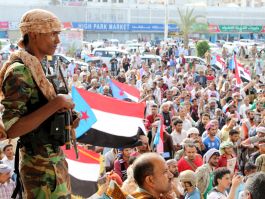Saudi ambitions in southern Yemen from independence to unity
YemenExtra
Y.A
Saudi Arabia’s ambitions in Yemen were not new, but were from the 1960s. While the National Front was resisting the British forces for independence on 30 November 1967, Saudi Arabia was making gains on the land of southern Yemen before independence
Many researchers have explained the Saudi hostility to the Yemeni revolutions in the north and south of Yemen in the 1960s to the fears of their rulers of exporting the revolution to the kingdom, but the hostility of Riyadh exceeded that to the project of the Yemeni unity. But many facts and evidence on the ground indicate that this hostility is due to the differences of the goals of the September and October revolutions as well as the unity project with Saudi expansionist ambitions in Yemeni territory.
The Southern National Front, which took the armed struggle as a single option to resist the British forces until independence in southern Yemen, had main goals, which are to expel the foreign colonizer ,topple the Palatine rule, restore the stolen lands and resources and achieve the unity of the people in the territory of Yemen. These goals were considered a threat to Saudi Arabia in the event of independence in the south, so, during the armed struggle in the south against the British forces, it consolidated its military presence in Yemeni Sharorah and Wadiah , which lies in the northern border of Hadramout, after being annexed by Britain during the demarcation of the southern border with Saudi Arabia to the south at the begining of the sixties of the last century and refused to recognize any Saudi presence there.
Saudi ambitions in the south
The independent state of the south led by the first president, Qahtan al-Shaabi, tried after months of independence to resolve the dispute peacefully about Sharorah and al-Wadiah and expressed its readiness to form a Saudi-Yemeni southern committee to discuss the issue of the border between the two countries. However, Saudi Arabia’s demands were to take Sharorah. Then disputes rose after Riyadh lost many of its arms in the South, especially the Sultans of Hadramout, to erupt the first southern war with Saudi Arabia on November 27, 1969, when the southern forces attacked the “Wadiah border center ” which was developed by Saudi Arabia deep in the territory of Yemen, and proceeded to Sharorah to restore it and exceeded Qarn al-Wadiah to reach the outstriks of Sharorah city , but Saudi Arabia considered the war «Marxist», and used the «Islamists» to support its forces. Under the leadership of the current King Salman bin Abdul Aziz, who led the Saudi forces, regained control of al-Wadiah and large areas in Sharorah during several military confrontations and subjected them by force to its control.
Annexation and attachment
These ambitions did not stop but the kingdom exploited the political instability experienced by the South Yemen state during the 1970s and 1980s to include large Yemeni lands ,belonging to Hadramout and al-Maharah, to it, depending on the mechanism of polarization to annex its inhabitants of the border areas to it through giving them Saudi nationalities and others to advance to dozens of villages on its eastern border , as a result a Saudi-Yemeni war was about to outbreak in December 1994 after the Saudi forces developed points and sites in the Khrakhir area of al-Mahrah, which is now belong to Saudi Arabia, and expanded in Sharorah , belonging to Hadramout, but Syrian and Egyptian interference with the leadership of the two countries defused the tension.
Saudi Arabia’s policy of annexation and attachement to Yemen, and its colonial ambitions, have now become clear. Riyadh has not only annexed dozens of the Mahri regions to its lands and annexed large areas in the Empty Quarter and in areas belonging to Hadramout, but it intended to take full control over al-Mahrah province under more than one pretext , such as fighting the smuggling, reconstructing and helping those affected by Hurricane Liban, which hit al-Mahrah last month, using force against the people of the province who reject their military presence on their land. It is noteworthy that the UAE presence can be left at any moment , but the Saudi incursion is much more dangerous due to neighborhood.
In March 2015, the US -backed –Saudi-led coalition started a war against Yemen with the declared aim of crushing the Houthi Ansarullah movement, who had taken over from the staunch Riyadh ally and fugitive former president Abd Rabbuh Mansur Hadi, while also seeking to secure the Saudi border with its southern neighbor. Three years and over 60,000 dead and injured Yemeni people and prevented the patients from travelling abroad for treatment and blocked the entry of medicine into the war-torn country, the war has yielded little to that effect.
Despite the coalition claims that it is bombing the positions of the Ansarullah fighters, Saudi bombers are flattening residential areas and civilian infrastructures.
More than 2,200 others have died of cholera, and the crisis has triggered what the United Nations has described as the world’s worst humanitarian disaster.

